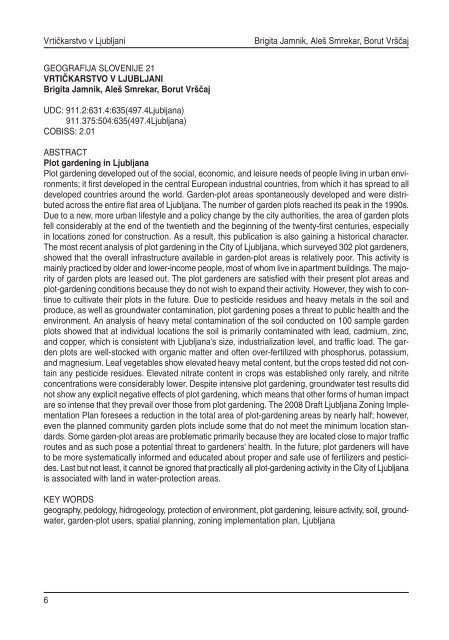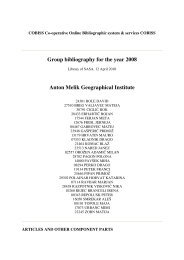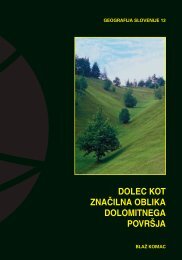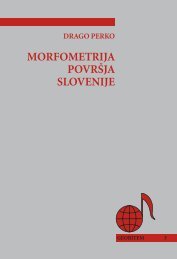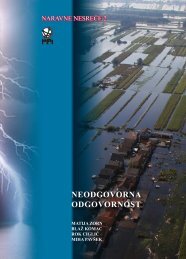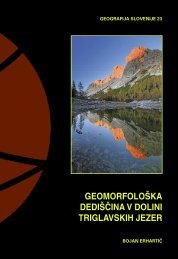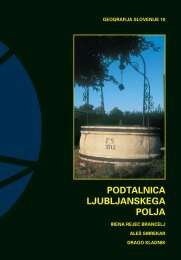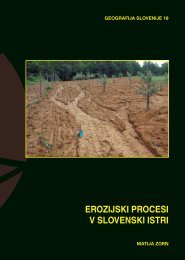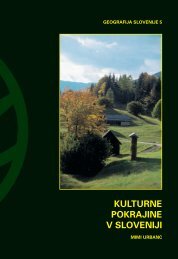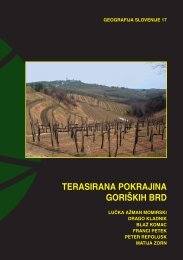vrti^karstvo v ljubljani - Geografski inštitut Antona Melika - ZRC SAZU
vrti^karstvo v ljubljani - Geografski inštitut Antona Melika - ZRC SAZU
vrti^karstvo v ljubljani - Geografski inštitut Antona Melika - ZRC SAZU
You also want an ePaper? Increase the reach of your titles
YUMPU automatically turns print PDFs into web optimized ePapers that Google loves.
Vrti~karstvo v LjubljaniBrigita Jamnik, Ale{ Smrekar, Borut Vr{~ajGEOGRAFIJA SLOVENIJE 21VRTI^KARSTVO V LJUBLJANIBrigita Jamnik, Ale{ Smrekar, Borut Vr{~ajUDC: 911.2:631.4:635(497.4Ljubljana)911.375:504:635(497.4Ljubljana)COBISS: 2.01ABSTRACTPlot gardening in LjubljanaPlot gardening developed out of the social, economic, and leisure needs of people living in urban environments;it first developed in the central European industrial countries, from which it has spread to alldeveloped countries around the world. Garden-plot areas spontaneously developed and were distributedacross the entire flat area of Ljubljana. The number of garden plots reached its peak in the 1990s.Due to a new, more urban lifestyle and a policy change by the city authorities, the area of garden plotsfell considerably at the end of the twentieth and the beginning of the twenty-first centuries, especiallyin locations zoned for construction. As a result, this publication is also gaining a historical character.The most recent analysis of plot gardening in the City of Ljubljana, which surveyed 302 plot gardeners,showed that the overall infrastructure available in garden-plot areas is relatively poor. This activity ismainly practiced by older and lower-income people, most of whom live in apartment buildings. The majorityof garden plots are leased out. The plot gardeners are satisfied with their present plot areas andplot-gardening conditions because they do not wish to expand their activity. However, they wish to continueto cultivate their plots in the future. Due to pesticide residues and heavy metals in the soil andproduce, as well as groundwater contamination, plot gardening poses a threat to public health and theenvironment. An analysis of heavy metal contamination of the soil conducted on 100 sample gardenplots showed that at individual locations the soil is primarily contaminated with lead, cadmium, zinc,and copper, which is consistent with Ljubljana's size, industrialization level, and traffic load. The gardenplots are well-stocked with organic matter and often over-fertilized with phosphorus, potassium,and magnesium. Leaf vegetables show elevated heavy metal content, but the crops tested did not containany pesticide residues. Elevated nitrate content in crops was established only rarely, and nitriteconcentrations were considerably lower. Despite intensive plot gardening, groundwater test results didnot show any explicit negative effects of plot gardening, which means that other forms of human impactare so intense that they prevail over those from plot gardening. The 2008 Draft Ljubljana Zoning ImplementationPlan foresees a reduction in the total area of plot-gardening areas by nearly half; however,even the planned community garden plots include some that do not meet the minimum location standards.Some garden-plot areas are problematic primarily because they are located close to major trafficroutes and as such pose a potential threat to gardeners' health. In the future, plot gardeners will haveto be more systematically informed and educated about proper and safe use of fertilizers and pesticides.Last but not least, it cannot be ignored that practically all plot-gardening activity in the City of Ljubljanais associated with land in water-protection areas.KEY WORDSgeography, pedology, hidrogeology, protection of environment, plot gardening, leisure activity, soil, groundwater,garden-plot users, spatial planning, zoning implementation plan, Ljubljana6


